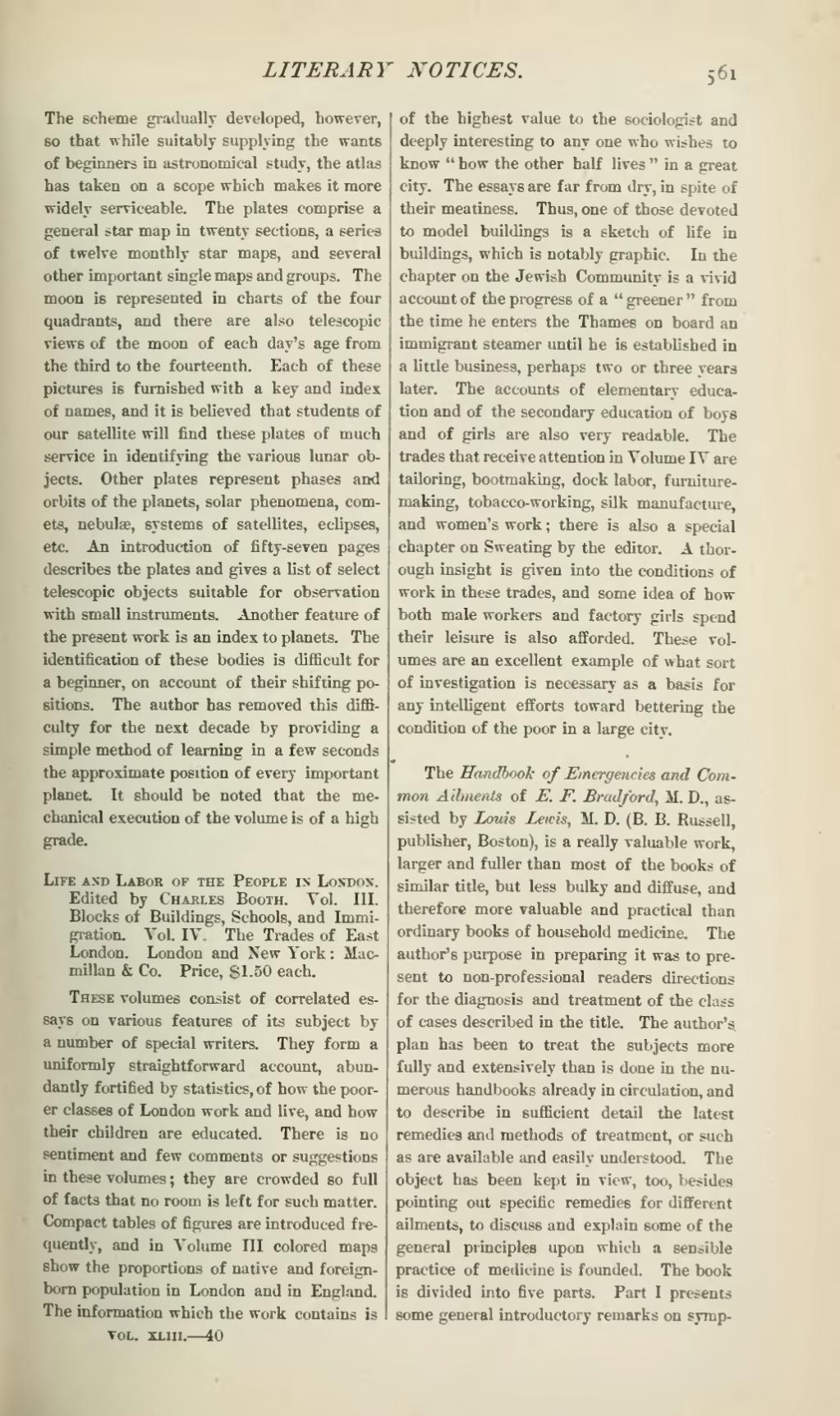The scheme gradually developed, however, so that while suitably supplying the wants of beginners in astronomical study, the atlas has taken on a scope which makes it more widely serviceable. The plates comprise a general star map in twenty sections, a series of twelve monthly star maps, and several other important single maps and groups. The moon is represented in charts of the four quadrants, and there are also telescopic views of the moon of each day's age from the third to the fourteenth. Each of these pictures is furnished with a key and index of names, and it is believed that students of our satellite will find these plates of much service in identifying the various lunar objects. Other plates represent phases and orbits of the planets, solar phenomena, comets, nebulas, systems of satellites, eclipses, etc. An introduction of fifty-seven pages describes the plates and gives a list of select telescopic objects suitable for observation with small instruments. Another feature of the present work is an index to planets. The identification of these bodies is difficult for a beginner, on account of their shifting positions. The author has removed this difficulty for the next decade by providing a simple method of learning in a few seconds the approximate position of every important planet. It should be noted that the mechanical execution of the volume is of a high grade.
Life and Labor of the People in London. Edited by Charles Booth. Vol. III Blocks of Buildings, Schools, and Immigration. Vol. IV. The Trades of East London. London and New York: Macmillan & Co. Price, $1.50 each.
These volumes consist of correlated essays on various features of its subject by a number of special writers. They form a uniformly straightforward account, abundantly fortified by statistics, of how the poorer classes of London work and live, and how their children are educated. There is no sentiment and few comments or suggestions in these volumes; they are crowded so full of facts that no room is left for such matter. Compact tables of figures are introduced frequently, and in Volume III colored maps show the proportions of native and foreign-born population in London and in England. The information which the work contains is of the highest value to the sociologist and deeply interesting to any one who wishes to know "how the other half lives" in a great city. The essays are far from dry, in spite of their meatiness. Thus, one of those devoted to model buildings is a sketch of life in buildings, which is notably graphic. In the chapter on the Jewish Community is a vivid account of the progress of a "greener" from the time he enters the Thames on board an immigrant steamer until he is established in a little business, perhaps two or three years later. The accounts of elementary education and of the secondary education of boys and of girls are also very readable. The trades that receive attention in Volume IV are tailoring, bootmaking, dock labor, furniture-making, tobacco-working, silk manufacture, and women's work; there is also a special chapter on Sweating by the editor. A thorough insight is given into the conditions of work in these trades, and some idea of how both male workers and factory girls spend their leisure is also afforded. These volumes are an excellent example of what sort of investigation is necessary as a basis for any intelligent efforts toward bettering the condition of the poor in a large city.
The Handbook of Emergencies and Common Ailments of E. F. Bradford, M. D., assisted by Louis Lewis, M. D. (B. B. Russell, publisher, Boston), is a really valuable work, larger and fuller than most of the books of similar title, but less bulky and diffuse, and therefore more valuable and practical than ordinary books of household medicine. The author's purpose in preparing it was to present to non-professional readers directions for the diagnosis and treatment of the class of cases described in the title. The author's plan has been to treat the subjects more fully and extensively than is done in the numerous handbooks already in circulation, and to describe in sufficient detail the latest remedies and methods of treatment, or such as are available and easily understood. The object has been kept in view, too, besides pointing out specific remedies for different ailments, to discuss and explain some of the general principles upon which a sensible practice of medicine is founded. The book is divided into five parts. Part I presents some general introductory remarks on symp-
